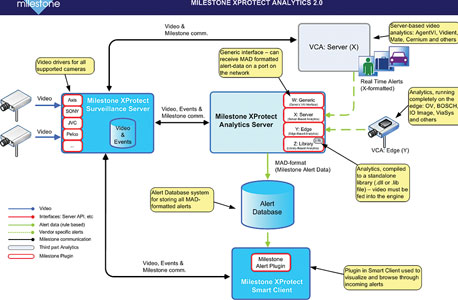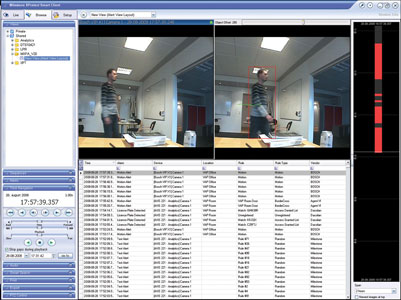


The advantages of an open platform IP video surveillance management solution for enabling video analytics – a Milestone white paper.
Digitalisation and IP networking are transforming the way that video surveillance and monitoring is used. Businesses, organisations and municipalities worldwide are increasingly looking to IP network video to improve the performance of their video surveillance and video-enable their operations. One of the most amazing ways IP network video can do this is by taking over the ‘seeing’.
Video analytics, video intelligence and video content analysis are all terms for the ability to mathematically detect, recognise and analyse objects and events using digitised video.
As video analytics has dramatically improved its effectiveness as a tool for providing realtime, actionable intelligence in security installations, it is getting serious attention for other uses as well. Its versatility provides excellent return on investment for a wide range of applications, including business intelligence, factory automation, loss prevention, public liability assessments, training, consumer behaviour analysis, monitoring traffic flow, and more.
The growing interest in video analytics is fuelling new innovations and products, and will continue to do so for some time to come. A report from IMS Research predicts that the video content analysis market will grow to an estimated USD 3,4 billion by 2010. But this is just the tip of the iceberg for the IP video surveillance industry as a whole. According to ABI Research, the video surveillance industry is at a key inflection point between analogue and digital technologies and could expand from USD 13,5 billion in revenue in 2006 to USD 46 billion in 2013.1 This means many more businesses and organisations will have the ability to video-enable their operations.
This paper will provide you with an overview of the state of video analytics today and where it is headed in the near future. We discuss the importance of building your video analytics capabilities on an open platform IP video surveillance management solution.
The need for video analytics
One of the most difficult and expensive aspects of video surveillance has always been the need to have people monitor the cameras. Without someone watching what the cameras are recording, there is no opportunity for immediate intervention or action. After all, what good is recording a shoplifting incident unless someone is observing it and can initiate an apprehension? What good is recording a break-in if you cannot mitigate property destruction and theft by responding quickly? Prosecution after the fact is valuable, but not as good as being able to respond to an incident as it is happening.
No matter what the usage, it is getting increasingly difficult and expensive for people to monitor the growing number of video surveillance cameras. Consider all the people you would need to monitor the 4,1 million surveillance cameras in the United Kingdom – the most watched society on earth. As you might expect, many of these cameras are not monitored. They just record. And record. And record.
What about motion detection? It has not been much of a help. Its poor ability to discriminate what it sees leads to many costly false alarms.
The fact is, as video surveillance systems grow in complexity and scale, they become increasingly demanding in their monitoring requirements. Today, advanced compression algorithms, such as H.264, promise to enable even more image data to be transmitted and stored. This makes it easier to have video systems with more channels, but who is going to monitor them? We believe that by 2012 the volume of video traffic on the Internet will outpace all other traffic from voice and other data. A lot of this will be video surveillance. The million-dollar question is who will be doing all the watching?
Even if you could get enough people to do it and afford paying them, chances are, they would not be very effective. Research in the US has shown human observers start showing signs of viewing fatigue after as little as 12 minutes, overlooking up to 45% of all activity in the scenes. After 22 minutes, they overlook up to 95%.2
There is also the issue of all that recorded and stored video. It contains a lot of valuable information for everything from prosecuting crimes to performing market research. However, even though video surveillance systems have been around for many years now, extracting useful information is still labour-intensive, time-consuming and tedious. It is an extremely hard task for people to review hours of video surveillance data from dozens (or, in some cases, hundreds) of cameras to find a particular incident that happened in a street, campus or building.
Making video surveillance more effective
All security footage records one of three events: no activity, inconsequential activity, and security issues. The biggest innovation in the surveillance industry today is the increasing success in teaching computers to distinguish between these three events through video analytics, and to provide realtime alerts.
Video analytics enable video surveillance to do the watching and become a proactive tool that signals the need for immediate intervention by guards, police, or other personnel. Video surveillance systems become more efficient when they can recognise situations and trigger alarms and other actions (such as gate and door locking). With video analytics acting as a remote observer, patrolling guards can receive notification of an intruder or other event, and potentially act before a crime takes place.
Video analytics also turn surveillance video into a gold mine for recording human behaviour for use in studying marketing effectiveness, creating training, improving building design, analysing traffic patterns and many other purposes. Today’s video analytics solutions not only can identify desired incidents, but also can encode video with metadata that makes it fast and easy to search through stored video for the clips that are pertinent to your needs. This can even include behaviours you may not have considered valuable to observe before the video was recorded. Instead of filling up hard drives with mystery video no one has the time to view, video analytics can turn surveillance video into a tool that organisations can profit from, for everything from research to improving operational efficiency.
Earlier shortcomings of video analytics
In the past, the use of video analytics has been stunted by three primary factors: false alerts, high maintenance requirements, and high costs.
False alerts happen for a variety of reasons and in themselves can be very costly. Early video analytics systems would generate dozens of false alarms daily due to:
* Deployment in environments for which they were not designed.
* Environmental factors like rain, dust or snow simulating human forms and motion.
* Quick changes in light.
* Poor mountings and other installation issues.
False alerts are costly because each alert necessitates checking a monitor for the camera’s current transmission (if responding to the alert immediately) or reviewing recorded video to ensure a real event has not transpired. This bleeds away the man-hour savings for which organisations buy video analytics. In the past, large video surveillance systems often generated dozens or hundreds of false alerts a day, significantly cutting into the labour savings.
Improper maintenance also often played a role in false alerts. Changes in the camera’s immediate environment, weather, sun position, or condition often hurt the efficacy of the system.
Finally, because of high price, many organisations were reluctant in the past to purchase the higher quality video analytics systems designed to significantly reduce false alerts. The high cost per channel was prohibitive. The result was they settled for lesser systems that, due to their more limited intelligence, suffered these much higher rates of false alerts. This proved a false economy as the many false alerts significantly impacted the expected cost savings that drove the original purchase.
Two factors have significantly changed the game: better video analytics systems and growing recognition of the true value of high quality video analytics.
Video analytics has come of age
Video analytics have improved dramatically in recent years. What has changed is the high level of accuracy with which video analytics systems can perform and the increasing number of tasks they can accomplish for security and business/organisational processes. Advancements in video analytics technology have increased recognition abilities, dramatically reducing false alerts due to weather, lighting, and other environmental factors. Even better, today’s video analytics can not only distinguish between humans and animals, but between loitering and normal activity. Recent video analytics systems, for instance, can distinguish between someone walking directly from a car and someone hanging around cars – the difference between a customer and a potential thief.
Some of the many video analytics capabilities available today include:
* Character (eg, alphanumeric) and inscription recognition for reading license plates, name tags, and containers
* Facial recognition.
* Density of people, people counts, behaviour (such as loitering, fighting, reading, sampling), slip-and-fall detection, gang activity, tailgating (vehicle or human) in restricted areas, a person coming over a fence.
* Object removal and tracking.
* Smoke detection.
* Pattern recognition and directional motion, speed.
* Tampering (such as with ATMs or other devices).
* Illegally parked cars, unattended bags, spills.
* Camera sabotage or malfunction.
There is even more power when you link several of these capabilities together. For example, it is now possible for a port or transportation yard to install a system where a fingerprint is linked to a driver’s face, to a tractor-trailer’s licence plate number, and the trailer or container identification numbers. The system can recognise and require all to match before automatically opening an entry/exit.
Today’s advanced systems can even spot potential problems by analysing how people move. The French government uses technology that can distinguish sightseers from the 40 to 50 people who try to climb the Eiffel Tower each year based on the way a would-be climber acts. The Statue of Liberty in New York has a similar system. Software scans video streams from 96 cameras simultaneously, directing security officials, who would otherwise become bleary-eyed staring at screens, to focus on particular activities. In Beijing, to help keep the spotlight on the games and prevent protests or other disruptions, security firms cover Beijing with smart video systems. These solutions analysed live video from hundreds of thousands of cameras and flaged suspicious people and objects.
A host of new digital products and solutions are enabling security and other departments to benefit from the latest technology. These include intelligent video codecs (computer programs that shrink large video files and make them easy to play and exchange on a network), intelligent IP cameras, and open IP platforms that enable anyone on the network who is authorised to access the feeds and stored video of various cameras. More powerful digital signal processors (DSPs) are enabling cameras to execute considerably more demanding software algorithms and identify specific objects or actions.
Server-based video analytics software products using highly specialised algorithms to analyse IP streaming signals are allowing image processing on the fly. Artificial intelligence is even enabling video analytics software to learn on the job. In response to these developments, false alarm rates are dramatically dropping and the ability to make fine distinctions in what is being seen is rapidly improving.

Adding greater business value and ROI
Video analytics provide excellent return on investment (ROI). Waste Management, a US recycling and waste management company with 2200 locations, calculates their video analytics system saved them $7,5 million in 2007.3 The system enabled them to reduce staff, travel and equipment, plus achieve faster response to incidents.
But that is only part of the picture. Video analytics also enable re-purposing video for business intelligence. The same company (Waste Management) reports that its accounting and operation departments use video analytics for business optimisation activities, such as monitoring point-of-sale displays and improving traffic patterns.
Retailers are a large market for video analytics. They use it to obtain information about customer flow, hot spots (places within the store that are most frequented by customers), queue management, product placement, and in-store advertising effectiveness. Video analytics has advanced enough to actually identify customer 'eyeball connections' with merchandise.
Other typical uses of video analytics include:
* Companies in the US, such as Brickstream and Shoppertrak, install video analytics systems to collect information about customer behaviour in banks, retail stores, grocery stores, gasoline stations, and other locations.
* The Smithsonian Museum uses a new camera system with video analytics to track traffic patterns and devise ways to increase museum store visits.
* Advertising agencies use video analytics to measure the impact of an ad on a passerby or bystander. These solutions can detect a face (including if it is male or female) as well as the facial movements – whether looking at the ad on the wall, and if so, for how long.
* Toll roads employ video analytics to study vehicle flow and respond to traffic incidents.
* Chicago METRA Electric District (METRA) in Chicago, Illinois (one of North America’s largest city transit companies) is installing high-resolution cameras and video analytics to continuously inspect METRA’s train pantographs (the metal frame on top of an electric locomotive that picks up electricity from cables hanging above the track). The video analytics detect suspicious anomalies suggesting defects.
There are hundreds more examples. One important key to success and good ROI in implementing video analytics is finding a solution provider who can understand your needs and effectively integrate analytics into your operations. This is a relatively new field and it is important for vendor and customer to work closely together to achieve the best results.
The place to start
One challenge in video analytics today is integrating user interfaces when video analytics solutions are used with a video surveillance system. This is particularly true if you are deploying several video analytics products (or plan to add new ones in the future). You do not want to overburden your staff with learning several different interfaces.
Open platform IP video surveillance management software like Milestone XProtect provides an invaluable framework for integrating and managing a wide variety of video analytics products under one interface. This is important because most video analytics systems offer one, or at most two, types of detections per camera, and the same one or two detections for all cameras in the system. Thus, to build a flexible system capable of detecting many types of security threats or collecting a variety of types of business intelligence, you need an open platform IP video surveillance management system that gives you a central console for controlling, operating and collecting data from all your video analytics solutions.

An open platform IP video surveillance management solution also enables greater integration between security systems such as an access control card reader and your surveillance cameras. By having video analytics watch an entry, you can reduce manpower while increasing accuracy. For example, if two people gain access by one card (tailgating), video analytics can alert a patrolling guard or central command station and provide a video clip for identification of the unauthorised person.
One of the biggest advantages of an open platform IP video surveillance management solution is that it enables the use of commercial off-the-shelf computing hardware. It gives you a platform where components from different manufacturers can be combined, added and upgraded over time to suit your needs and budget. This lowers your total cost of ownership (TCO) and provides greater flexibility in meeting your evolving security or other surveillance needs.
The fact is, each manufacturer of a component of a security system – whether it is an intelligent IP network camera, video analytics software, access control system, etc, – is good at producing their component, but someone needs to provide the overall interface. It is this central interface that enables the user to unlock all the power of using these devices and use them together as a total solution. That is the role of the platform. And that is why you need to carefully select it right from the beginning, or make a transition to a more comprehensive platform if you find yourself limited by your current one.
Server-based or edge – or both?
As processors in cameras get more powerful and video analytics algorithms demand less processing power, many types of video analytics can be performed either at the server or at the edge (on camera). Performing video content analytics at the edge helps conserve overall processing capacity since the video analytics is done before the image is compressed. This means that the image will not need to be decompressed at the server again for video content analysis. Instead, metadata (data about data) provides the necessary information for easy identification and retrieval.
A truly future-proof solution is one that enables some part of video analytics at both points – server and edge. This is partly because some types of video content analysis will always require the greater processing power and speed of a central server and also because we will see more and more edge products with the capability of performing some video content analysis. As this happens, the need for a strong video management system with an analytics framework will become even more evident as the value of querying across metadata from different edge devices from different vendors will be very high.
On-camera analytics
Performing video analytics at the edge can significantly reduce bandwidth demands. You can set up your system to store only video identified as being ‘of interest’ – such as clips indicating a security breach, unauthorised entry or fulfilling other criteria. In this case, you manage by exception to normal events, collecting what the on-camera analytics are designed to recognise.
On-camera analytics can be a solution for two of the biggest deterrents to the widespread adoption of megapixel (high-resolution) cameras: bandwidth and storage. In fact, the two work hand in hand. Megapixel cameras provide the detail necessary for many video analytics products to perform complex operations. On-camera video analytics can make sure you only disseminate through the network and store video of interest.
Today’s on-camera analytics are capable of processing images in realtime and encoding archived video with metadata in MPEG or other formats. This metadata enables indexing of the relevant image content for fast retrieval. In fact, adding meta tags for user-defined events allows retrieval within seconds of specific events from hours of video from thousands of cameras.
The latest generation of IP network cameras combine recent chip design advancements with better compression technologies (such as H.264) to enable high definition with less bandwidth. This further paves the way for large-scale surveillance systems using megapixel cameras and on-camera analytics. In addition, advanced digital signal processing (DSP) technologies bring even better on-camera video analytics within reach. Hardware accelerators do the heavy lifting of encode/decode and display, enabling the DSP to handle the intense processing requirements of video analytics. Several DSP makers have teamed with different video analytics developers to release camera reference designs, and there are several standardisation attempts in the marketplace today. Standard reference designs – and recent efforts to put analytics on board cameras using one chip instead of two or more – promise to lower the price per channel over time.
Server-based analytics
On-camera analytics make sense for the images coming from one particular camera. When you need to perform analytics or correlate metadata on live or stored video from hundreds of cameras, you need the greater processing power and central management capabilities of a server-based solution. Server-based analytics enable more complex analytics and fast searches through archived video. Server solutions are critical for making a variety of video analytics tools available to various departments, from security to HR, operations and marketing, and allowing searches for after-the-fact criteria or analytics (such as facial recognition or object identification) that are beyond the capabilities of on-camera solutions.
A relatively new solution, image processing over IP (IPoIP) technology, distributes the image processing responsibilities between camera and server. The video analytics algorithms are segmented into two parts and divided between the video encoder hardware and the central image-processing server. IPoIP retains the strengths of both distributed on-camera and server architectures, while avoiding their limitations.
How should you set up your system? This ultimately comes down to your needs, as well as the IP video surveillance management solution you choose, the cameras, the video analytics solutions, and the various hardware components. A qualified solution provider will be able to help you make the right choices.
References
1. 'Video Surveillance Systems: Explosive Market Growth and New Market Opportunities', ABIresearch, 2008.
2. Robert Moore, citing a 2002 study published in Security Oz magazine in his article 'What are the latest trends in intelligent video and analytics?' SP&T News, June 6, 2008. See: www.sptnews.ca/index.php/Editorials/Ask-the-Expert-Smarter-AI/menu-id-106.html
3. 'Video Analytics Means Lots of Savings, Little Waste at Waste Management', Security Systems News, April 2008.
| Tel: | +27 10 500 8793 |
| Email: | [email protected] |
| www: | www.milestonesys.com |
| Articles: | More information and articles about Milestone Systems |

© Technews Publishing (Pty) Ltd. | All Rights Reserved.